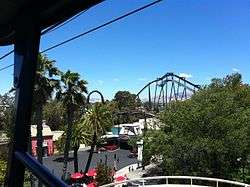Flight Deck (California's Great America)
Flight Deck (formerly Top Gun) is a steel inverted roller coaster located at California's Great America in Northern California. Built by Bolliger & Mabillard, Flight Deck made its debut March 19, 1993 as Top Gun.[1] This was Bolliger & Mabillard's second inverted coaster behind Batman: The Ride at Six Flags Great America. The third inverted coaster from Bolliger & Mabillard opened a little under two months later at Six Flags Great Adventure. Flight Deck at California's Great America isn't quite as tall, nor as fast or long (in length) as its partner, Afterburn at Carowinds.
| Flight Deck | |
|---|---|
| Previously known as Top Gun | |
 | |
| California's Great America | |
| Location | California's Great America |
| Park section | Orleans Place |
| Coordinates | 37°23′53.10″N 121°58′18.63″W |
| Status | Operating |
| Opening date | March 19, 1993 |
| General statistics | |
| Type | Steel – Inverted |
| Manufacturer | Bolliger & Mabillard |
| Designer | Werner Stengel |
| Model | Custom |
| Height | 102 ft (31 m) |
| Drop | 91 ft (28 m) |
| Length | 2,260 ft (690 m) |
| Speed | 50 mph (80 km/h) |
| Inversions | 3 |
| Duration | 2:26 |
| Capacity | 1330 riders per hour |
| G-force | 4.5 |
| Height restriction | 54 in (137 cm) |
| Trains | 2 trains with 7 cars. Riders are arranged 4 across in a single row for a total of 28 riders per train. |
| Flight Deck at RCDB Pictures of Flight Deck at RCDB | |
Flight Deck was also featured in a commercial for Excedrin in 2007.
History
The Park opened the ride in 1993 as the first custom B&M Invert. The roller coaster opened as Top Gun. The color scheme when it opened was all black. The ride was themed around the film Top Gun, including the playing of music from the film's soundtrack in the queue area. After Paramount sold off Great America to Cedar Fair, along with all their other parks in 2006, the Top Gun theming was removed and the name has changed to Flight Deck. Later in 2014, the color scheme of the track and supports were changed to red and white, respectively.
Ride experience
The ride begins with a small right-hand turn followed by the 102-foot (31 meter) lift hill. The drop at the top of the hill begins with a sharp left turn. After the initial drop of 91 feet (27 meters), the train reaches its maximum speed of 50 miles per hour (80 kilometers per hour). Flight Deck then enters a vertical loop. The ride then performs a banked 3/4 turn to the right followed by a zero-gravity roll. Following this, the train makes a short dive over the entrance sign and then banks left into a flat turn, passing the ride's station. After this, there is a shallow drop immediately followed by a corkscrew over a nearby pond . The ride features another 3/4 turn, this time banking to the left. Finally, the train turns right into the brake run and station.
Ride elements
- Vertical Loop
- Zero-G-Roll
- Corkscrew
References
- Marden, Duane. "Flight Deck (California's Great America)". Roller Coaster DataBase. Retrieved April 5, 2012.
External links
| Wikimedia Commons has media related to Flight Deck (California's Great America). |